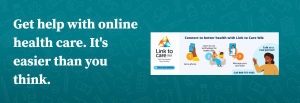Like many safety net clinics, Yakima Neighborhood Health Services wants to improve equitable access to telehealth visits, particularly now that such visits are woven into the daily fabric of medical care. Yakima Neighborhood Health Services is located in Central Washington, a two-plus-hour drive from Seattle. Situated in a fertile valley, the area is known for its agriculture—think apple orchards and grape vineyards. Latinos make up about 45 percent of the population.

In addition to primary care, dental, vision, and behavioral health services, the center provides specialized services, including food programs for children and pregnant and breastfeeding women; educational classes for people with diabetes; services for people experiencing homelessness, and supportive programs for teens and young adults. Established in 1975 inside a tiny house, Yakima Neighborhood Health is now a health center with 10 permanent sites and two mobile sites; one of its buildings is a former cow herd facility. In another nod to its humble, community-oriented roots, in days past the clinic met its payroll by selling BBQ and fireworks. These days, the clinic serves more than 23,000 patients with more than 90,000 visits annually.
One population it would like to do a better job serving via telehealth: its homeless clients and patients in permanent supportive housing, some of whom don’t have or aren’t very familiar with digital devices. As one client explained: “If you are not tech savvy, you will be left behind.”
So as part of CCI’s Virtual Care Innovation Program, the health center’s goals were to enhance access to digital health care for patients experiencing homelessness by increasing their use of both the patient portal for prescription refills and telehealth appointments by 5 percent. It also wanted to improve their technology skills.

Wine grapes in Yakima, WA., where many residents work in the vineyards. *(Credit: Shutterstock)
During the course of the program, the health center quickly discovered through patient surveys and interviews that this particular patient subset—currently housed in both apartment buildings and individual homes—did have some familiarity with smart phones, which they typically used for entertainment and job searches. There was a baseline comfort and confidence with using these devices, says Michelle Sullivan, chief quality and compliance officer for Yakima Neighborhood Health Services. For the most part, though, they had no experience using smart phones as a way to access health care services.
So it made sense for the health center to hone its focus on portal access (the health center uses Intellichart for its patient portal and the video-based platform OTTO for telehealth appointments.) The center’s website portal is available in English and Spanish; a small percentage of patients—Sullivan estimates under 15 percent—in this pilot program are monolingual Spanish speakers.
It took some education and persuading to bring patients along. “What we thought would be well received initially wasn’t,” says Sullivan. “Many of our patients didn’t want to have a telehealth connection.” Rather than being discouraged, the health center embraced the challenge.
“A learning process for all parties”
Some patients, in particular those with mental health diagnoses, were especially distrustful of telehealth, citing privacy concerns. In addition, Wi-Fi access in the area can be challenging even for residents with more resources than this cohort. Securing access to the Internet was a big hurdle, says Sullivan, but staff found work-arounds. In some of the supportive housing, the health center provided Internet access. Community health workers helped patients locate free or low-cost phones and access government-funded broadband services.
Washington State does offer one-stop shopping in a central resource called Link to Care WA, a state-funded online and telephone-based service powered by the Community Health Network of Washington, a coalition of 21 community health centers across the state that operate more than 140 clinics.

Many Yakima residents also work in apple orchards (Shutterstock)
The Link to Care WA network’s goal is to get more vulnerable people connected to health care by providing them with the tools and support they need to access and manage care online and by phone, including locating low-cost phones and connecting to discounted Internet, helping patients gather the confidence to use online tools, and helping patients set up telehealth appointments and access prescription refills online. The resource is available in more than 20 languages. (In the Yakima clinic pilot, patients connecting by phone had one-on-one in-person assistance from a community health worker. In Link to Care WA, they could receive in-person and/or remote assistance and support.)
The health center had to do its share of patient education. Patients soon reported the phones were broken or didn’t work. It took a month to figure out that, in fact, the phones were fine: the users were simply plowing through data too fast. Community health workers educated patients on how to save data by turning off apps not in use and other strategies. It was a learning process for all parties, says Sullivan. During the pandemic, typical community resources such as public libraries, which often offer free W-Fi, were closed, adding another layer of challenge to the trial project.
With so many obstacles, the Yakima clinic didn’t reached its goal of a 5 percent increase in telehealth visits, but it did make impressive progress on its other goal. It went from having only two patients experiencing homelessness enrolled in the portal in July 2021 to 64 patients enrolled by April 2022. Similarly, in July of last year the clinic had no prescription refill requests via portal from patients experiencing homeless, but from July 2021 through April 2022 they had 176 such requests.
Portal access helps patients hone online skills
Increasing patient portal access has been a pet project of many safety net clinics—even before the pandemic hit. For example, for more than five years, the Los Angeles County Department of Health Services (LADHS), has made impressive progress in this arena. In 2020, as part of CCI’s Technology Hub program, LADHS boosted enrolment with a festive staff incentive program. See our story here. And in 2019, as part of CCI’s Catalyst program, LADHS bumped up portal sign ups at a clinic with previous low engagement. See our story here. When the department brought in OpenNotes in January 2018, active patients on the county’s then-patient portal, MyWellness, increased by 100 percent over the year, from 12,500 a month in January 2018 to 24,000 a month in December that same year. (The county’s patient portal is now called the LA Health Portal.)
It’s not just urban health clinics that have been working to bolster patient portal use. See our story on West County Health Centers’ efforts in rural Sebastopol, California to implement online patient portals as part of a case study series also on CCI’s Technology Hub program.
This kind of education can have a spillover effect. As Sullivan notes, helping clients develop tech skills can transfer to other aspects of life. During the pandemic, so much work, school, and college took place remotely and required a level of online proficiency for participation. As the clinic’s website says: “Get help with online health care. It’s easier than you think.”

Graphic on Yakima clinic website
Lessons Learned
Seek patient participation from the start
. It’s vital to get clients’ input early on, in interviews and surveys. They will likely have different perceptions and opinions about what the problems, barriers, and solutions are than those the health care team consider the big issues.
Get a handle on the technology challenges early on
Figure out where your patient population stands on the digital literacy spectrum and work from there. Are they challenged by the devices themselves, the data piece, and/or online platforms or applications? Having a better understanding of where the pain points are can help with efficiency and troubleshooting.
Engage community health workers
These members of the healthcare team can offer the kind of time and tech support that can make the difference between patients coming on board or giving up on healthcare access online. This kind of peer support from people with lived experience can be crucial to a program’s success—and can bridge many gaps, from signing patients up for telehealth, to ensuring they have vaccinations and access other health services. They can also help “test” patient skills and set up practice video visits.
_____________________________________________________________________
The Virtual Care Innovation Network is a community health collaboration founded and funded by Kaiser Permanente in partnership with CCI, National Health Care for the Homeless Council, the primary care associations in each of the nine states in which Kaiser Permanente provides care, and regional associations in California. Its goal is to design or redesign virtual care models so they continue after the pandemic abates and beyond. VCIN seeks to solve some of the complex challenges associated with the implementation, improvement, and sustainability of virtual care, also commonly known as telehealth or telemedicine.
Find this useful or interesting? We’re constantly sharing stuff like this. Sign up to receive our newsletter to stay in the loop.

